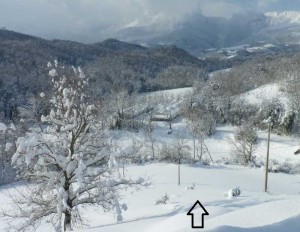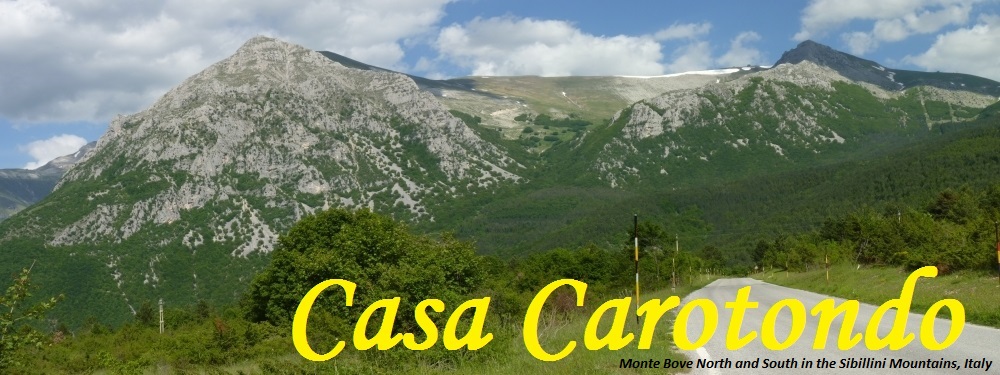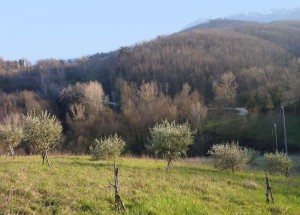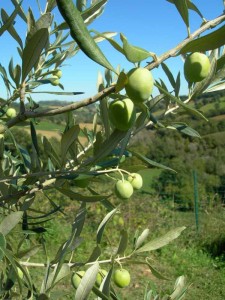Casa Carotondo is perched on top of a hill some of which (the south-west facing bit) belongs to us. It is difficult to know how to use the land productively; apart from planting olive trees and vines. We had not been here long when we found out you can buy olive trees – two years old – for only four Euros each, it seemed an obvious thing to do. We would produce our own olive oil! Of course everyone associates olives and olive trees with Italy. You see olive trees growing in most areas of the country, so naively we thought it would be a straightforward thing to do.
The man in the shop told us the trees would start producing olives at about four years old. Of course he didn’t mention and we didn’t think in our enthusiasm that they would only produce a few olives to begin with – to produce one litre of oil you need upwards of 5 kilos. Shortly after planting our trees we bumped into the previous owner of our property who pointed at our trees, gesticulated wildly and bemoaned il vento (the wind) in agonised tones. It is true that Casa Carotondo is subject to gale force winds especially in the winter months mostly from the west ie. the mountains, but at the time we thought he was exaggerating. You often see olive trees in Italy planted on steep slopes open to gales from the Mediterranean. However the winds have had a detrimental effect on our trees since then and we have had to deal with broken branches as a result. On the other hand the following year Adolfo planted 100 small olive trees on the north side of our hill – the bit he still owns.
Growing olive trees at 550m above sea level (the altitude at which we live) is common. 700 meters is considered to be about the limit for successful olive tree cultivation. However we do experience snow in winter, the weight of which can lead to (more) broken branches. When possible we knock the snow off the trees – but sometimes it is difficult to keep up. The biggest threat to the trees, as we found out a couple of years ago, is frost. The olive tree is an evergreen and holds sap in its branches throughout the winter. If the tree experiences too much cold the branches literally freeze, expand and split. The year we experienced this frost, the trees all revived again; but two years of growth is required before olives will reappear on the tree.

Olive trees in the snow in February 2012 at Casa Carotondo, Le Marche, Italy. We had about a meter of snow.
The reason for two years of growth is that the tree sets the flower buds in the autumn. The flowers then bloom in late May/June and the fruit appears in the following autumn. The first year was required for branches to grow back and then to set the flower buds. The flowers of the olive tree are pollinated by the wind not bees. It is best to have a mixture of cultivars to produce quality oil – we have Leccine and Frantoio – and a few Pendolino trees to aid pollination. Care needs to be taken choosing the trees you plant. They need to be suitable for your area and soil and be able to cross-pollinate. When we bought our trees we knew nothing about cultivars, luckily the man in the shop advised us and the shop only sells the cultivars used locally.
In northern Europe we tend to think of olive trees as not needing any water. In the Mediterranean it is true that mature olive trees tend not to be irrigated. Apparently a certain amount of water stress is good for the oil flavour. However smaller trees definitely need water during the dry summer months to prevent them possibly from dying but certainly from stunted growth. Although they need a certain amount of water they do not like to stand in it, which is why planting olives on a slope is a good idea. During the wet winter months the water drains away from their roots. The time the olive tree really needs water is the autumn when the olive fruit is developing. This is a time when we have actually lost young trees, forgetting to water them, thinking that now it is autumn the weather is wetter; however light showers and a low water table in the soil can be disastrous. Irrigation at this time may be necessary, to keep young trees healthy and to help develop the fruit in time for harvest.
What we didn’t think about when we planted our trees was the logistics of watering them – largely because we were ignorant of their requirements. We planted them too far apart on a steep slope so that watering them is a bit of slog and done reluctantly. However giving the tree plenty of space means that when mature their root systems will be able to source water from a wider area.
The most difficult part of the olive tree cultivation, because it requires real expertise, is the pruning. It can pay to have it done professionally at least once to see how it is done. There is literature on the subject but mostly it tells you that the tree needs to be opened up to the light and air and all vertical twigs removed. It will then tell you that each area has its own methods of pruning and you should find out how it is done in your area. In our area they have a bowl like shape taking out the top and middle of the tree to get the sunlight into the middle of the tree to ripen fruit at the bottom of the tree. (Olives need a certain amount of direct sunlight each day). It also keeps the tree at a more manageable size to make harvesting easier. Fruit tends to grow on the branches that droop downwards rather than horizontal or vertical so these need to be maintained. Traditionally pruning is done in spring. Warm dry weather is needed for the cuts made by pruning to heal quickly and pruning will spur the tree into new growth.
The fruit is harvested in early November in this region. Harvest time depends on the area, the type of tree and the quality of oil required. An early harvest will give you better quality oil but less quantity. There are various ways to collect the fruit but manual picking is still the best to prevent damage to the fruit. It is then taken as quickly as possible to the frantoio where the olives are pressed and the oil is produced.
We have four Ascolana olive trees for eating olives. These olives are indigenous to the area and can be stuffed – Olive all’Ascolana. These olives are picked in October (earlier than the oil olives) and then have to be processed to remove the acid, which makes them bitter, before they can be eaten. Traditionally the ascolana olives are first soaked in diluted caustic soda – yes, the stuff you use to unblock drains and clean the floor with. They are then rinsed for several days afterwards to remove the soda and the remaining acid, before being stored in brine.
As with some other things in our lives here in Italy growing olive trees has not been as easy as expected, there have been some setbacks and there has been a lot to learn. We look forward to the day when we can offer guests staying in our holiday apartments a complimentary bottle of our own extra-virgin oil. Until that day we carry on with the watering and fertilizing of the trees as well as the improvement of our pruning techniques. We hope the olive fly and frost will stay away and we continue to buy oil at the supermarket!


